ACCT20074 Contemporary Accounting Theory: Financial Reporting Report
VerifiedAdded on 2023/03/31
|19
|4171
|397
Report
AI Summary
This report provides an analysis of the conceptual framework for financial reporting and sustainability/integrated reporting in corporate social responsibility. Part A examines the history and development of the conceptual framework, focusing on the reasons for its adoption in the USA, UK, and Australia, as well as globally under the IASB. It also discusses concerns of the Australian accounting profession regarding the application of the IASB framework and the limitations affecting its quality. An analysis of Unibail-Rodamco-Westfield's (URW) financial reporting practices is included, focusing on the recognition of revenue, assets, and liabilities. Part B explores sustainability reporting under the GRI framework and integrated reporting under the IIRC framework, highlighting similarities and differences. The report emphasizes the importance of non-financial information and the need for companies to balance financial and non-financial information in their reporting.
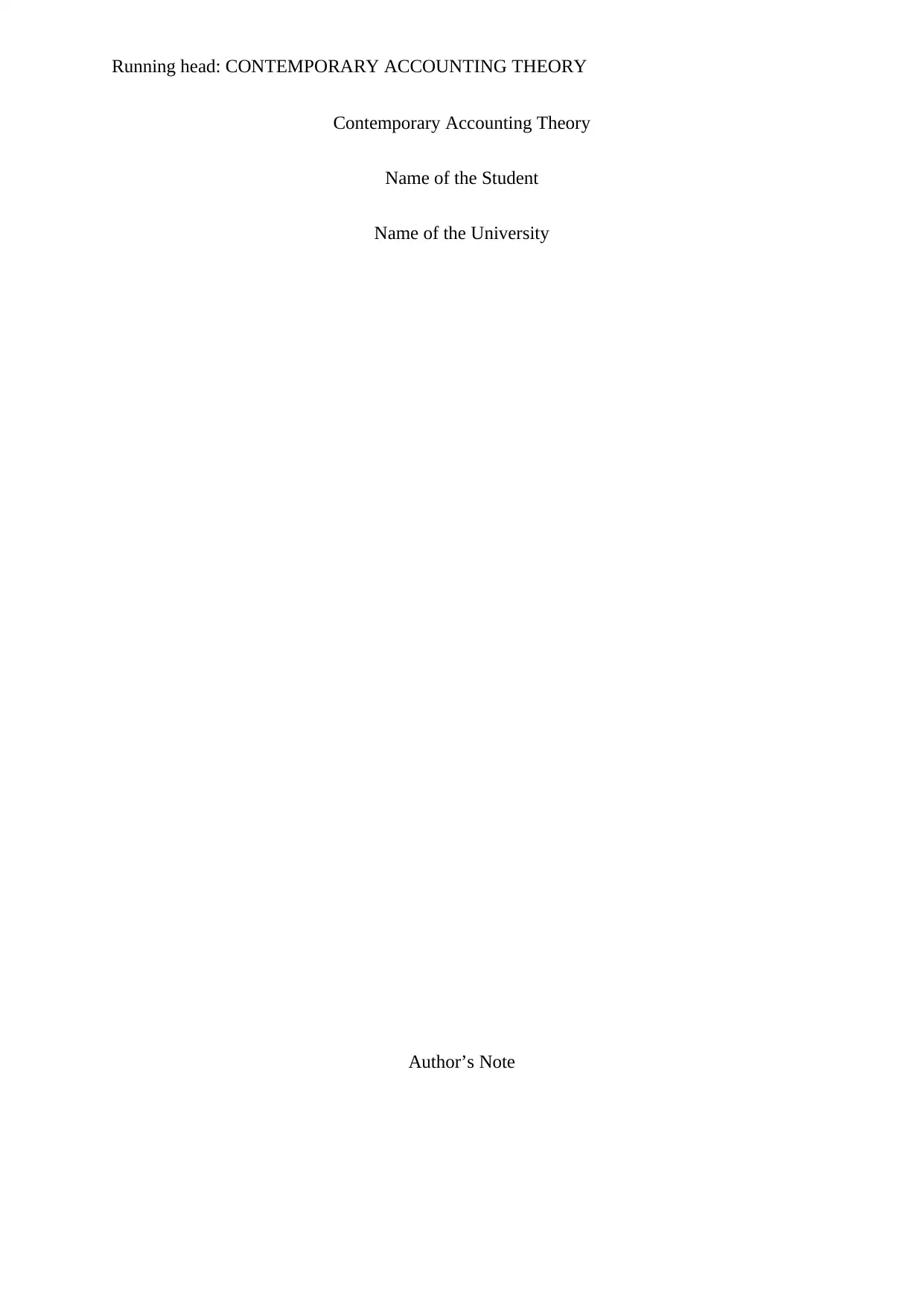
Running head: CONTEMPORARY ACCOUNTING THEORY
Contemporary Accounting Theory
Name of the Student
Name of the University
Author’s Note
Contemporary Accounting Theory
Name of the Student
Name of the University
Author’s Note
Paraphrase This Document
Need a fresh take? Get an instant paraphrase of this document with our AI Paraphraser
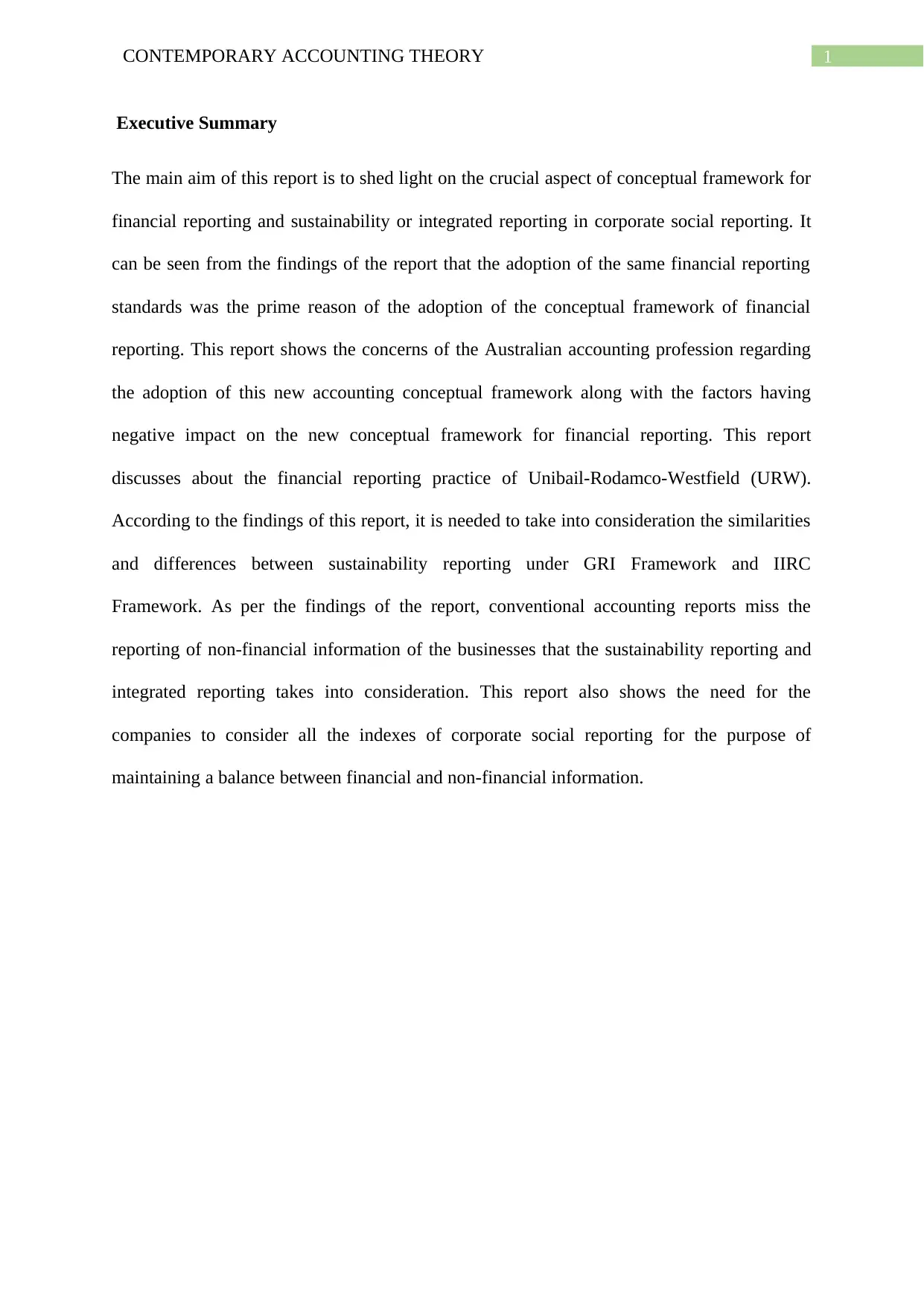
1CONTEMPORARY ACCOUNTING THEORY
Executive Summary
The main aim of this report is to shed light on the crucial aspect of conceptual framework for
financial reporting and sustainability or integrated reporting in corporate social reporting. It
can be seen from the findings of the report that the adoption of the same financial reporting
standards was the prime reason of the adoption of the conceptual framework of financial
reporting. This report shows the concerns of the Australian accounting profession regarding
the adoption of this new accounting conceptual framework along with the factors having
negative impact on the new conceptual framework for financial reporting. This report
discusses about the financial reporting practice of Unibail-Rodamco-Westfield (URW).
According to the findings of this report, it is needed to take into consideration the similarities
and differences between sustainability reporting under GRI Framework and IIRC
Framework. As per the findings of the report, conventional accounting reports miss the
reporting of non-financial information of the businesses that the sustainability reporting and
integrated reporting takes into consideration. This report also shows the need for the
companies to consider all the indexes of corporate social reporting for the purpose of
maintaining a balance between financial and non-financial information.
Executive Summary
The main aim of this report is to shed light on the crucial aspect of conceptual framework for
financial reporting and sustainability or integrated reporting in corporate social reporting. It
can be seen from the findings of the report that the adoption of the same financial reporting
standards was the prime reason of the adoption of the conceptual framework of financial
reporting. This report shows the concerns of the Australian accounting profession regarding
the adoption of this new accounting conceptual framework along with the factors having
negative impact on the new conceptual framework for financial reporting. This report
discusses about the financial reporting practice of Unibail-Rodamco-Westfield (URW).
According to the findings of this report, it is needed to take into consideration the similarities
and differences between sustainability reporting under GRI Framework and IIRC
Framework. As per the findings of the report, conventional accounting reports miss the
reporting of non-financial information of the businesses that the sustainability reporting and
integrated reporting takes into consideration. This report also shows the need for the
companies to consider all the indexes of corporate social reporting for the purpose of
maintaining a balance between financial and non-financial information.
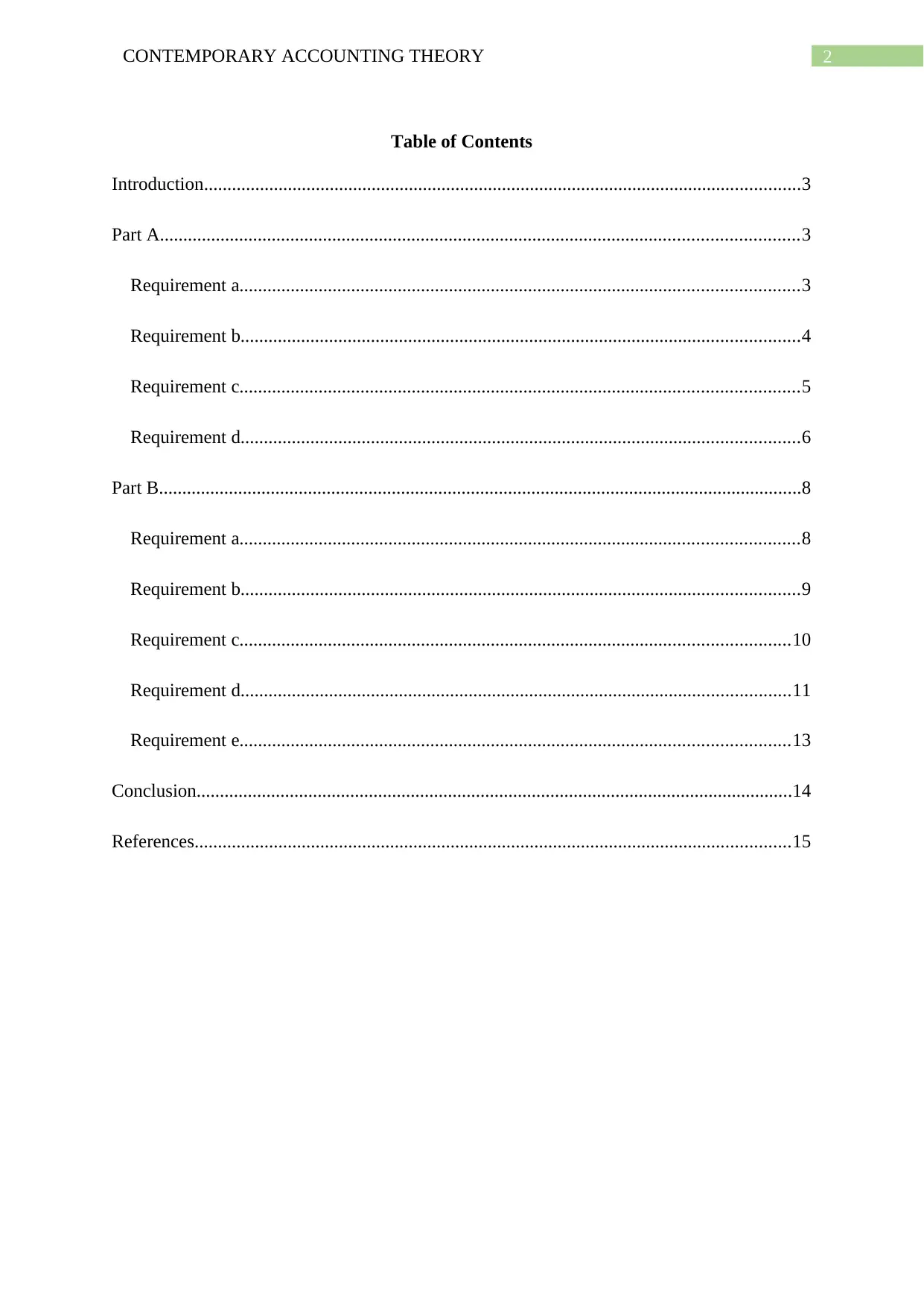
2CONTEMPORARY ACCOUNTING THEORY
Table of Contents
Introduction................................................................................................................................3
Part A.........................................................................................................................................3
Requirement a........................................................................................................................3
Requirement b........................................................................................................................4
Requirement c........................................................................................................................5
Requirement d........................................................................................................................6
Part B..........................................................................................................................................8
Requirement a........................................................................................................................8
Requirement b........................................................................................................................9
Requirement c......................................................................................................................10
Requirement d......................................................................................................................11
Requirement e......................................................................................................................13
Conclusion................................................................................................................................14
References................................................................................................................................15
Table of Contents
Introduction................................................................................................................................3
Part A.........................................................................................................................................3
Requirement a........................................................................................................................3
Requirement b........................................................................................................................4
Requirement c........................................................................................................................5
Requirement d........................................................................................................................6
Part B..........................................................................................................................................8
Requirement a........................................................................................................................8
Requirement b........................................................................................................................9
Requirement c......................................................................................................................10
Requirement d......................................................................................................................11
Requirement e......................................................................................................................13
Conclusion................................................................................................................................14
References................................................................................................................................15
⊘ This is a preview!⊘
Do you want full access?
Subscribe today to unlock all pages.

Trusted by 1+ million students worldwide
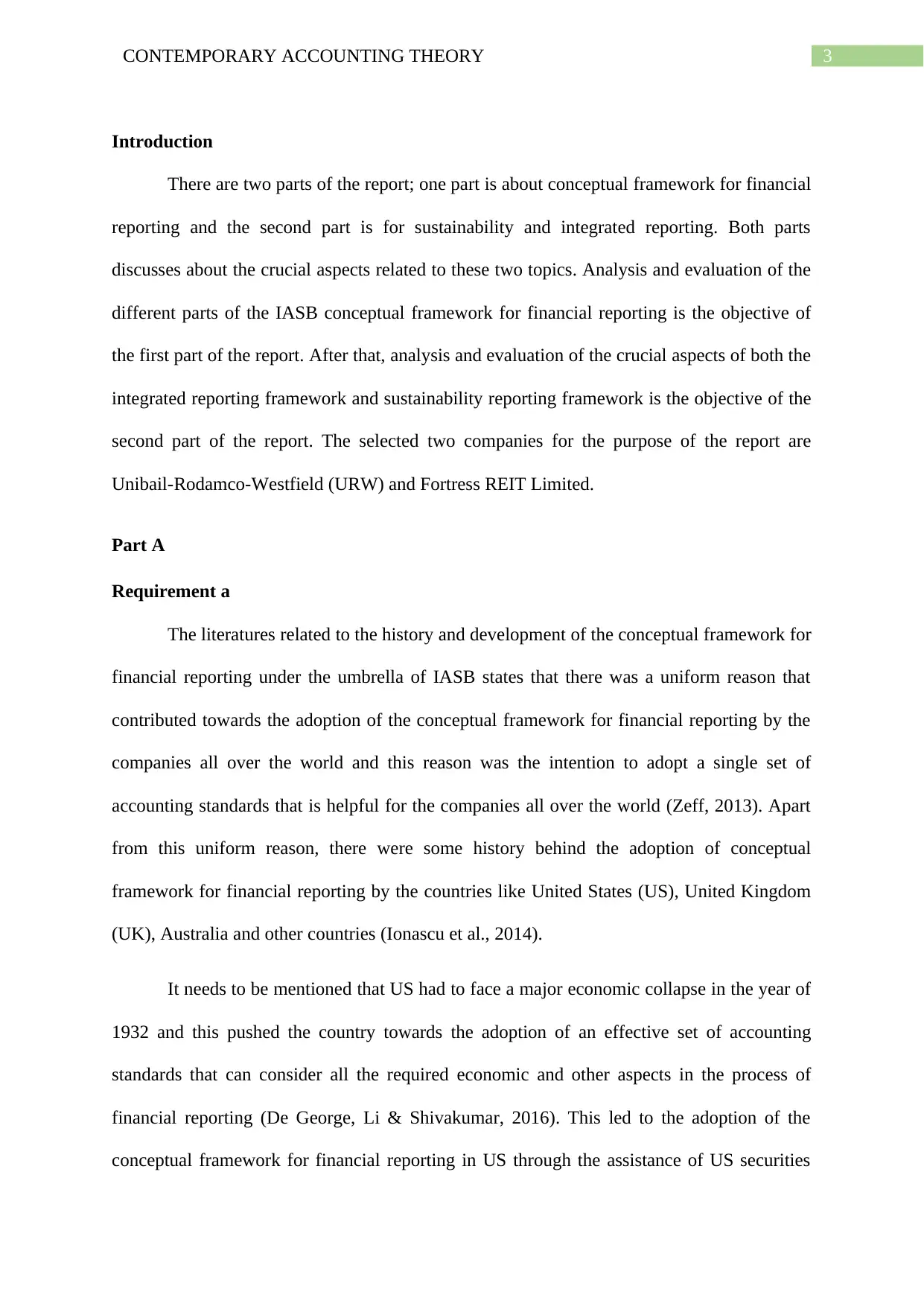
3CONTEMPORARY ACCOUNTING THEORY
Introduction
There are two parts of the report; one part is about conceptual framework for financial
reporting and the second part is for sustainability and integrated reporting. Both parts
discusses about the crucial aspects related to these two topics. Analysis and evaluation of the
different parts of the IASB conceptual framework for financial reporting is the objective of
the first part of the report. After that, analysis and evaluation of the crucial aspects of both the
integrated reporting framework and sustainability reporting framework is the objective of the
second part of the report. The selected two companies for the purpose of the report are
Unibail-Rodamco-Westfield (URW) and Fortress REIT Limited.
Part A
Requirement a
The literatures related to the history and development of the conceptual framework for
financial reporting under the umbrella of IASB states that there was a uniform reason that
contributed towards the adoption of the conceptual framework for financial reporting by the
companies all over the world and this reason was the intention to adopt a single set of
accounting standards that is helpful for the companies all over the world (Zeff, 2013). Apart
from this uniform reason, there were some history behind the adoption of conceptual
framework for financial reporting by the countries like United States (US), United Kingdom
(UK), Australia and other countries (Ionascu et al., 2014).
It needs to be mentioned that US had to face a major economic collapse in the year of
1932 and this pushed the country towards the adoption of an effective set of accounting
standards that can consider all the required economic and other aspects in the process of
financial reporting (De George, Li & Shivakumar, 2016). This led to the adoption of the
conceptual framework for financial reporting in US through the assistance of US securities
Introduction
There are two parts of the report; one part is about conceptual framework for financial
reporting and the second part is for sustainability and integrated reporting. Both parts
discusses about the crucial aspects related to these two topics. Analysis and evaluation of the
different parts of the IASB conceptual framework for financial reporting is the objective of
the first part of the report. After that, analysis and evaluation of the crucial aspects of both the
integrated reporting framework and sustainability reporting framework is the objective of the
second part of the report. The selected two companies for the purpose of the report are
Unibail-Rodamco-Westfield (URW) and Fortress REIT Limited.
Part A
Requirement a
The literatures related to the history and development of the conceptual framework for
financial reporting under the umbrella of IASB states that there was a uniform reason that
contributed towards the adoption of the conceptual framework for financial reporting by the
companies all over the world and this reason was the intention to adopt a single set of
accounting standards that is helpful for the companies all over the world (Zeff, 2013). Apart
from this uniform reason, there were some history behind the adoption of conceptual
framework for financial reporting by the countries like United States (US), United Kingdom
(UK), Australia and other countries (Ionascu et al., 2014).
It needs to be mentioned that US had to face a major economic collapse in the year of
1932 and this pushed the country towards the adoption of an effective set of accounting
standards that can consider all the required economic and other aspects in the process of
financial reporting (De George, Li & Shivakumar, 2016). This led to the adoption of the
conceptual framework for financial reporting in US through the assistance of US securities
Paraphrase This Document
Need a fresh take? Get an instant paraphrase of this document with our AI Paraphraser
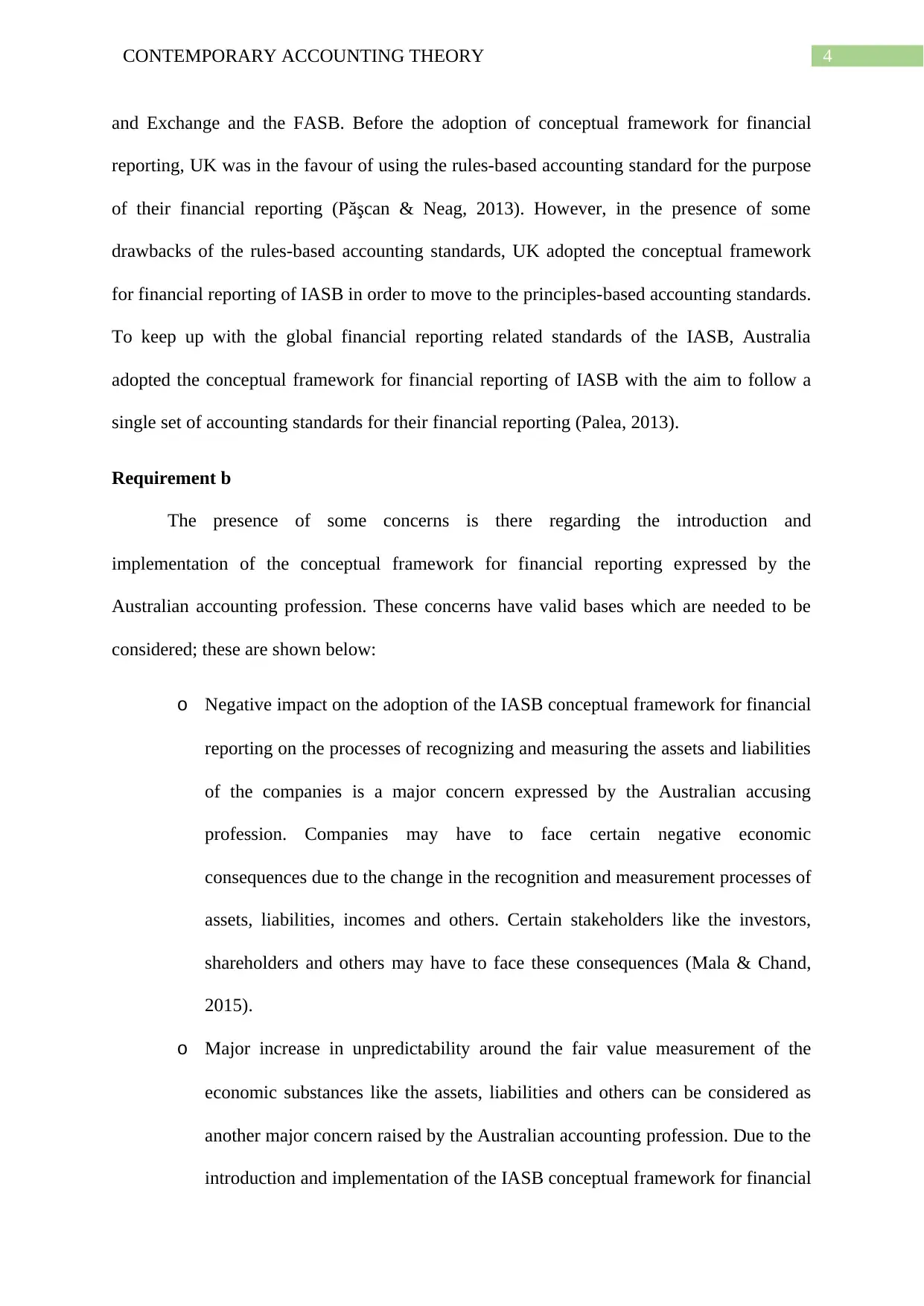
4CONTEMPORARY ACCOUNTING THEORY
and Exchange and the FASB. Before the adoption of conceptual framework for financial
reporting, UK was in the favour of using the rules-based accounting standard for the purpose
of their financial reporting (Păşcan & Neag, 2013). However, in the presence of some
drawbacks of the rules-based accounting standards, UK adopted the conceptual framework
for financial reporting of IASB in order to move to the principles-based accounting standards.
To keep up with the global financial reporting related standards of the IASB, Australia
adopted the conceptual framework for financial reporting of IASB with the aim to follow a
single set of accounting standards for their financial reporting (Palea, 2013).
Requirement b
The presence of some concerns is there regarding the introduction and
implementation of the conceptual framework for financial reporting expressed by the
Australian accounting profession. These concerns have valid bases which are needed to be
considered; these are shown below:
o Negative impact on the adoption of the IASB conceptual framework for financial
reporting on the processes of recognizing and measuring the assets and liabilities
of the companies is a major concern expressed by the Australian accusing
profession. Companies may have to face certain negative economic
consequences due to the change in the recognition and measurement processes of
assets, liabilities, incomes and others. Certain stakeholders like the investors,
shareholders and others may have to face these consequences (Mala & Chand,
2015).
o Major increase in unpredictability around the fair value measurement of the
economic substances like the assets, liabilities and others can be considered as
another major concern raised by the Australian accounting profession. Due to the
introduction and implementation of the IASB conceptual framework for financial
and Exchange and the FASB. Before the adoption of conceptual framework for financial
reporting, UK was in the favour of using the rules-based accounting standard for the purpose
of their financial reporting (Păşcan & Neag, 2013). However, in the presence of some
drawbacks of the rules-based accounting standards, UK adopted the conceptual framework
for financial reporting of IASB in order to move to the principles-based accounting standards.
To keep up with the global financial reporting related standards of the IASB, Australia
adopted the conceptual framework for financial reporting of IASB with the aim to follow a
single set of accounting standards for their financial reporting (Palea, 2013).
Requirement b
The presence of some concerns is there regarding the introduction and
implementation of the conceptual framework for financial reporting expressed by the
Australian accounting profession. These concerns have valid bases which are needed to be
considered; these are shown below:
o Negative impact on the adoption of the IASB conceptual framework for financial
reporting on the processes of recognizing and measuring the assets and liabilities
of the companies is a major concern expressed by the Australian accusing
profession. Companies may have to face certain negative economic
consequences due to the change in the recognition and measurement processes of
assets, liabilities, incomes and others. Certain stakeholders like the investors,
shareholders and others may have to face these consequences (Mala & Chand,
2015).
o Major increase in unpredictability around the fair value measurement of the
economic substances like the assets, liabilities and others can be considered as
another major concern raised by the Australian accounting profession. Due to the
introduction and implementation of the IASB conceptual framework for financial
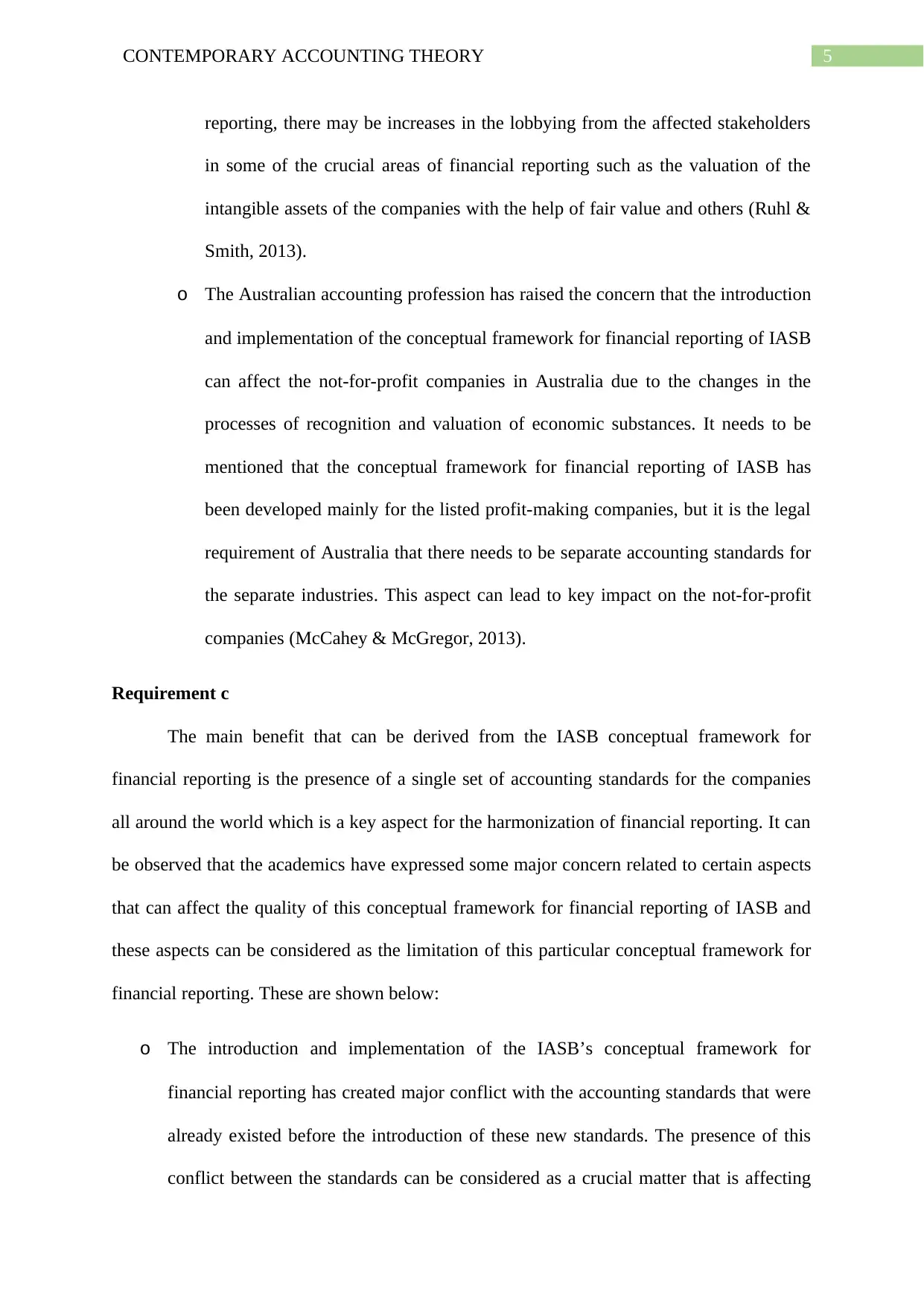
5CONTEMPORARY ACCOUNTING THEORY
reporting, there may be increases in the lobbying from the affected stakeholders
in some of the crucial areas of financial reporting such as the valuation of the
intangible assets of the companies with the help of fair value and others (Ruhl &
Smith, 2013).
o The Australian accounting profession has raised the concern that the introduction
and implementation of the conceptual framework for financial reporting of IASB
can affect the not-for-profit companies in Australia due to the changes in the
processes of recognition and valuation of economic substances. It needs to be
mentioned that the conceptual framework for financial reporting of IASB has
been developed mainly for the listed profit-making companies, but it is the legal
requirement of Australia that there needs to be separate accounting standards for
the separate industries. This aspect can lead to key impact on the not-for-profit
companies (McCahey & McGregor, 2013).
Requirement c
The main benefit that can be derived from the IASB conceptual framework for
financial reporting is the presence of a single set of accounting standards for the companies
all around the world which is a key aspect for the harmonization of financial reporting. It can
be observed that the academics have expressed some major concern related to certain aspects
that can affect the quality of this conceptual framework for financial reporting of IASB and
these aspects can be considered as the limitation of this particular conceptual framework for
financial reporting. These are shown below:
o The introduction and implementation of the IASB’s conceptual framework for
financial reporting has created major conflict with the accounting standards that were
already existed before the introduction of these new standards. The presence of this
conflict between the standards can be considered as a crucial matter that is affecting
reporting, there may be increases in the lobbying from the affected stakeholders
in some of the crucial areas of financial reporting such as the valuation of the
intangible assets of the companies with the help of fair value and others (Ruhl &
Smith, 2013).
o The Australian accounting profession has raised the concern that the introduction
and implementation of the conceptual framework for financial reporting of IASB
can affect the not-for-profit companies in Australia due to the changes in the
processes of recognition and valuation of economic substances. It needs to be
mentioned that the conceptual framework for financial reporting of IASB has
been developed mainly for the listed profit-making companies, but it is the legal
requirement of Australia that there needs to be separate accounting standards for
the separate industries. This aspect can lead to key impact on the not-for-profit
companies (McCahey & McGregor, 2013).
Requirement c
The main benefit that can be derived from the IASB conceptual framework for
financial reporting is the presence of a single set of accounting standards for the companies
all around the world which is a key aspect for the harmonization of financial reporting. It can
be observed that the academics have expressed some major concern related to certain aspects
that can affect the quality of this conceptual framework for financial reporting of IASB and
these aspects can be considered as the limitation of this particular conceptual framework for
financial reporting. These are shown below:
o The introduction and implementation of the IASB’s conceptual framework for
financial reporting has created major conflict with the accounting standards that were
already existed before the introduction of these new standards. The presence of this
conflict between the standards can be considered as a crucial matter that is affecting
⊘ This is a preview!⊘
Do you want full access?
Subscribe today to unlock all pages.

Trusted by 1+ million students worldwide
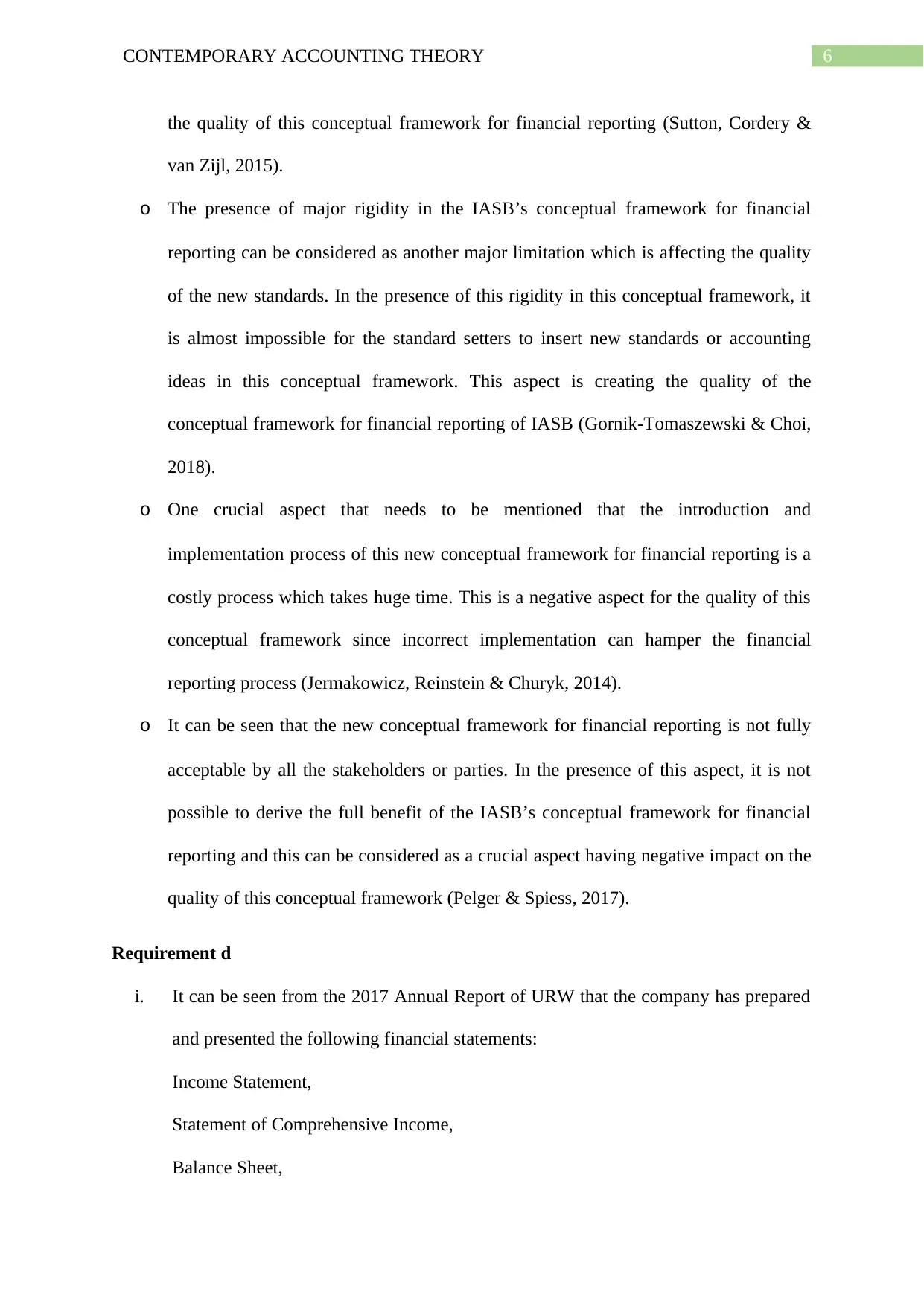
6CONTEMPORARY ACCOUNTING THEORY
the quality of this conceptual framework for financial reporting (Sutton, Cordery &
van Zijl, 2015).
o The presence of major rigidity in the IASB’s conceptual framework for financial
reporting can be considered as another major limitation which is affecting the quality
of the new standards. In the presence of this rigidity in this conceptual framework, it
is almost impossible for the standard setters to insert new standards or accounting
ideas in this conceptual framework. This aspect is creating the quality of the
conceptual framework for financial reporting of IASB (Gornik-Tomaszewski & Choi,
2018).
o One crucial aspect that needs to be mentioned that the introduction and
implementation process of this new conceptual framework for financial reporting is a
costly process which takes huge time. This is a negative aspect for the quality of this
conceptual framework since incorrect implementation can hamper the financial
reporting process (Jermakowicz, Reinstein & Churyk, 2014).
o It can be seen that the new conceptual framework for financial reporting is not fully
acceptable by all the stakeholders or parties. In the presence of this aspect, it is not
possible to derive the full benefit of the IASB’s conceptual framework for financial
reporting and this can be considered as a crucial aspect having negative impact on the
quality of this conceptual framework (Pelger & Spiess, 2017).
Requirement d
i. It can be seen from the 2017 Annual Report of URW that the company has prepared
and presented the following financial statements:
Income Statement,
Statement of Comprehensive Income,
Balance Sheet,
the quality of this conceptual framework for financial reporting (Sutton, Cordery &
van Zijl, 2015).
o The presence of major rigidity in the IASB’s conceptual framework for financial
reporting can be considered as another major limitation which is affecting the quality
of the new standards. In the presence of this rigidity in this conceptual framework, it
is almost impossible for the standard setters to insert new standards or accounting
ideas in this conceptual framework. This aspect is creating the quality of the
conceptual framework for financial reporting of IASB (Gornik-Tomaszewski & Choi,
2018).
o One crucial aspect that needs to be mentioned that the introduction and
implementation process of this new conceptual framework for financial reporting is a
costly process which takes huge time. This is a negative aspect for the quality of this
conceptual framework since incorrect implementation can hamper the financial
reporting process (Jermakowicz, Reinstein & Churyk, 2014).
o It can be seen that the new conceptual framework for financial reporting is not fully
acceptable by all the stakeholders or parties. In the presence of this aspect, it is not
possible to derive the full benefit of the IASB’s conceptual framework for financial
reporting and this can be considered as a crucial aspect having negative impact on the
quality of this conceptual framework (Pelger & Spiess, 2017).
Requirement d
i. It can be seen from the 2017 Annual Report of URW that the company has prepared
and presented the following financial statements:
Income Statement,
Statement of Comprehensive Income,
Balance Sheet,
Paraphrase This Document
Need a fresh take? Get an instant paraphrase of this document with our AI Paraphraser
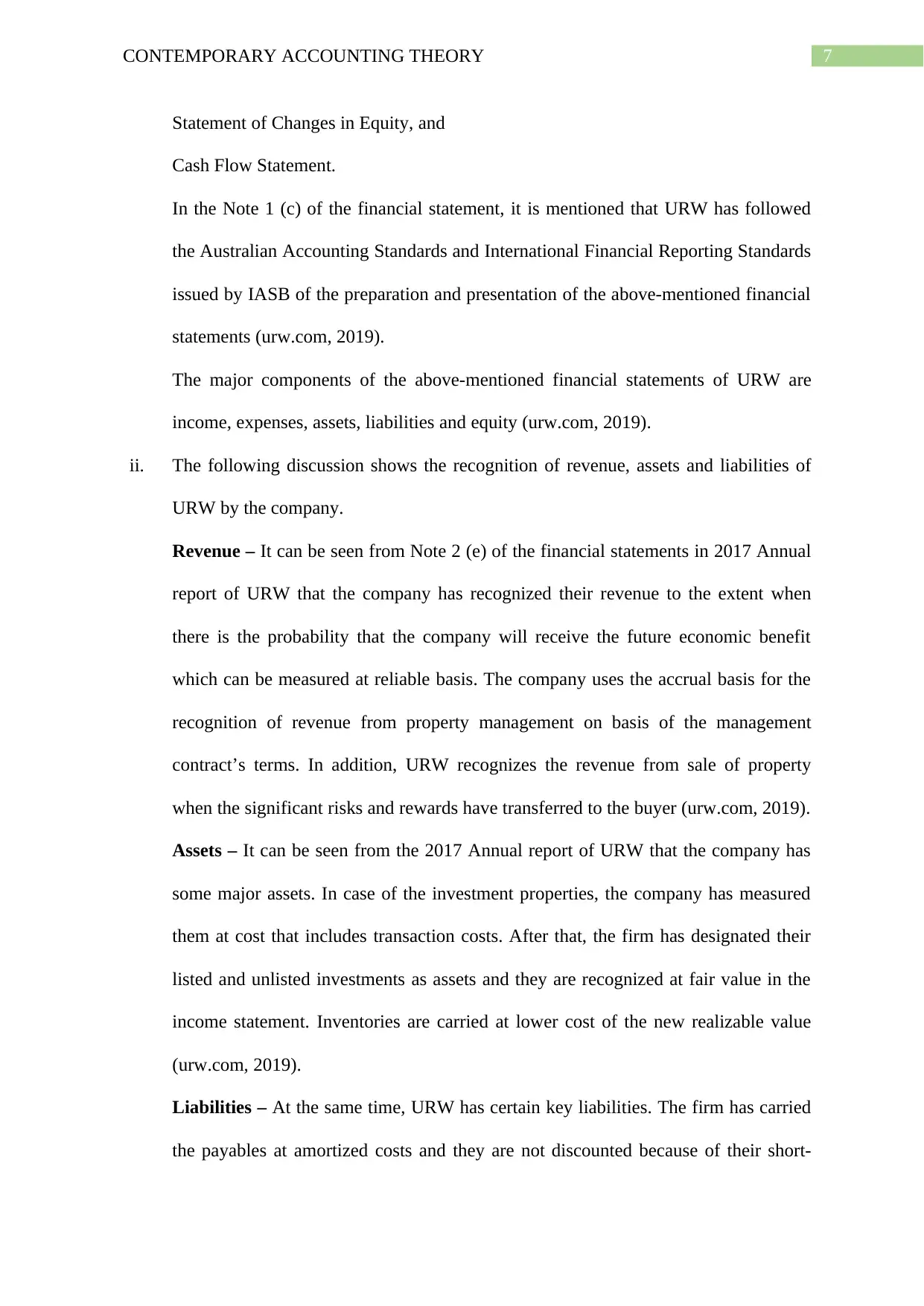
7CONTEMPORARY ACCOUNTING THEORY
Statement of Changes in Equity, and
Cash Flow Statement.
In the Note 1 (c) of the financial statement, it is mentioned that URW has followed
the Australian Accounting Standards and International Financial Reporting Standards
issued by IASB of the preparation and presentation of the above-mentioned financial
statements (urw.com, 2019).
The major components of the above-mentioned financial statements of URW are
income, expenses, assets, liabilities and equity (urw.com, 2019).
ii. The following discussion shows the recognition of revenue, assets and liabilities of
URW by the company.
Revenue – It can be seen from Note 2 (e) of the financial statements in 2017 Annual
report of URW that the company has recognized their revenue to the extent when
there is the probability that the company will receive the future economic benefit
which can be measured at reliable basis. The company uses the accrual basis for the
recognition of revenue from property management on basis of the management
contract’s terms. In addition, URW recognizes the revenue from sale of property
when the significant risks and rewards have transferred to the buyer (urw.com, 2019).
Assets – It can be seen from the 2017 Annual report of URW that the company has
some major assets. In case of the investment properties, the company has measured
them at cost that includes transaction costs. After that, the firm has designated their
listed and unlisted investments as assets and they are recognized at fair value in the
income statement. Inventories are carried at lower cost of the new realizable value
(urw.com, 2019).
Liabilities – At the same time, URW has certain key liabilities. The firm has carried
the payables at amortized costs and they are not discounted because of their short-
Statement of Changes in Equity, and
Cash Flow Statement.
In the Note 1 (c) of the financial statement, it is mentioned that URW has followed
the Australian Accounting Standards and International Financial Reporting Standards
issued by IASB of the preparation and presentation of the above-mentioned financial
statements (urw.com, 2019).
The major components of the above-mentioned financial statements of URW are
income, expenses, assets, liabilities and equity (urw.com, 2019).
ii. The following discussion shows the recognition of revenue, assets and liabilities of
URW by the company.
Revenue – It can be seen from Note 2 (e) of the financial statements in 2017 Annual
report of URW that the company has recognized their revenue to the extent when
there is the probability that the company will receive the future economic benefit
which can be measured at reliable basis. The company uses the accrual basis for the
recognition of revenue from property management on basis of the management
contract’s terms. In addition, URW recognizes the revenue from sale of property
when the significant risks and rewards have transferred to the buyer (urw.com, 2019).
Assets – It can be seen from the 2017 Annual report of URW that the company has
some major assets. In case of the investment properties, the company has measured
them at cost that includes transaction costs. After that, the firm has designated their
listed and unlisted investments as assets and they are recognized at fair value in the
income statement. Inventories are carried at lower cost of the new realizable value
(urw.com, 2019).
Liabilities – At the same time, URW has certain key liabilities. The firm has carried
the payables at amortized costs and they are not discounted because of their short-
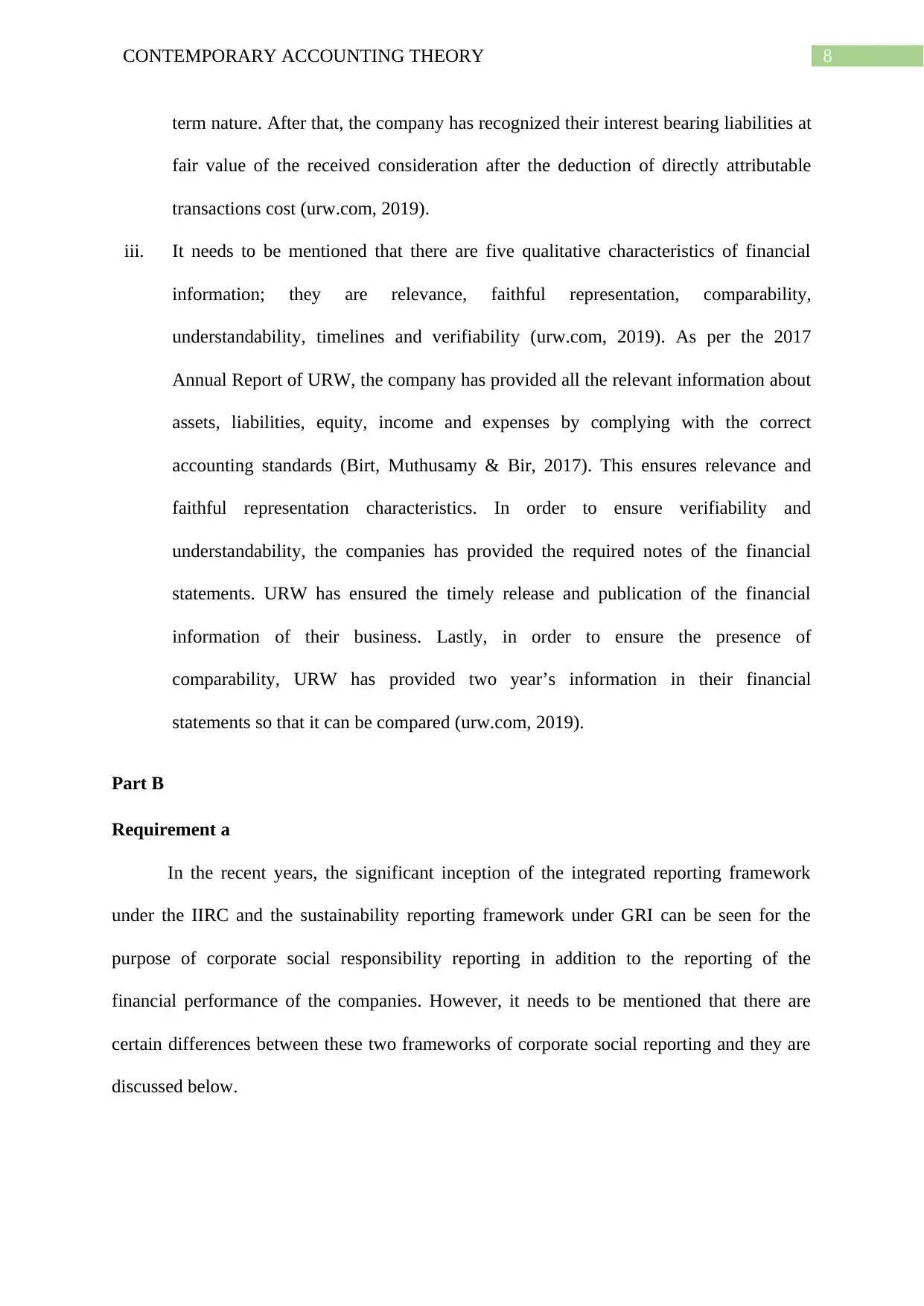
8CONTEMPORARY ACCOUNTING THEORY
term nature. After that, the company has recognized their interest bearing liabilities at
fair value of the received consideration after the deduction of directly attributable
transactions cost (urw.com, 2019).
iii. It needs to be mentioned that there are five qualitative characteristics of financial
information; they are relevance, faithful representation, comparability,
understandability, timelines and verifiability (urw.com, 2019). As per the 2017
Annual Report of URW, the company has provided all the relevant information about
assets, liabilities, equity, income and expenses by complying with the correct
accounting standards (Birt, Muthusamy & Bir, 2017). This ensures relevance and
faithful representation characteristics. In order to ensure verifiability and
understandability, the companies has provided the required notes of the financial
statements. URW has ensured the timely release and publication of the financial
information of their business. Lastly, in order to ensure the presence of
comparability, URW has provided two year’s information in their financial
statements so that it can be compared (urw.com, 2019).
Part B
Requirement a
In the recent years, the significant inception of the integrated reporting framework
under the IIRC and the sustainability reporting framework under GRI can be seen for the
purpose of corporate social responsibility reporting in addition to the reporting of the
financial performance of the companies. However, it needs to be mentioned that there are
certain differences between these two frameworks of corporate social reporting and they are
discussed below.
term nature. After that, the company has recognized their interest bearing liabilities at
fair value of the received consideration after the deduction of directly attributable
transactions cost (urw.com, 2019).
iii. It needs to be mentioned that there are five qualitative characteristics of financial
information; they are relevance, faithful representation, comparability,
understandability, timelines and verifiability (urw.com, 2019). As per the 2017
Annual Report of URW, the company has provided all the relevant information about
assets, liabilities, equity, income and expenses by complying with the correct
accounting standards (Birt, Muthusamy & Bir, 2017). This ensures relevance and
faithful representation characteristics. In order to ensure verifiability and
understandability, the companies has provided the required notes of the financial
statements. URW has ensured the timely release and publication of the financial
information of their business. Lastly, in order to ensure the presence of
comparability, URW has provided two year’s information in their financial
statements so that it can be compared (urw.com, 2019).
Part B
Requirement a
In the recent years, the significant inception of the integrated reporting framework
under the IIRC and the sustainability reporting framework under GRI can be seen for the
purpose of corporate social responsibility reporting in addition to the reporting of the
financial performance of the companies. However, it needs to be mentioned that there are
certain differences between these two frameworks of corporate social reporting and they are
discussed below.
⊘ This is a preview!⊘
Do you want full access?
Subscribe today to unlock all pages.

Trusted by 1+ million students worldwide
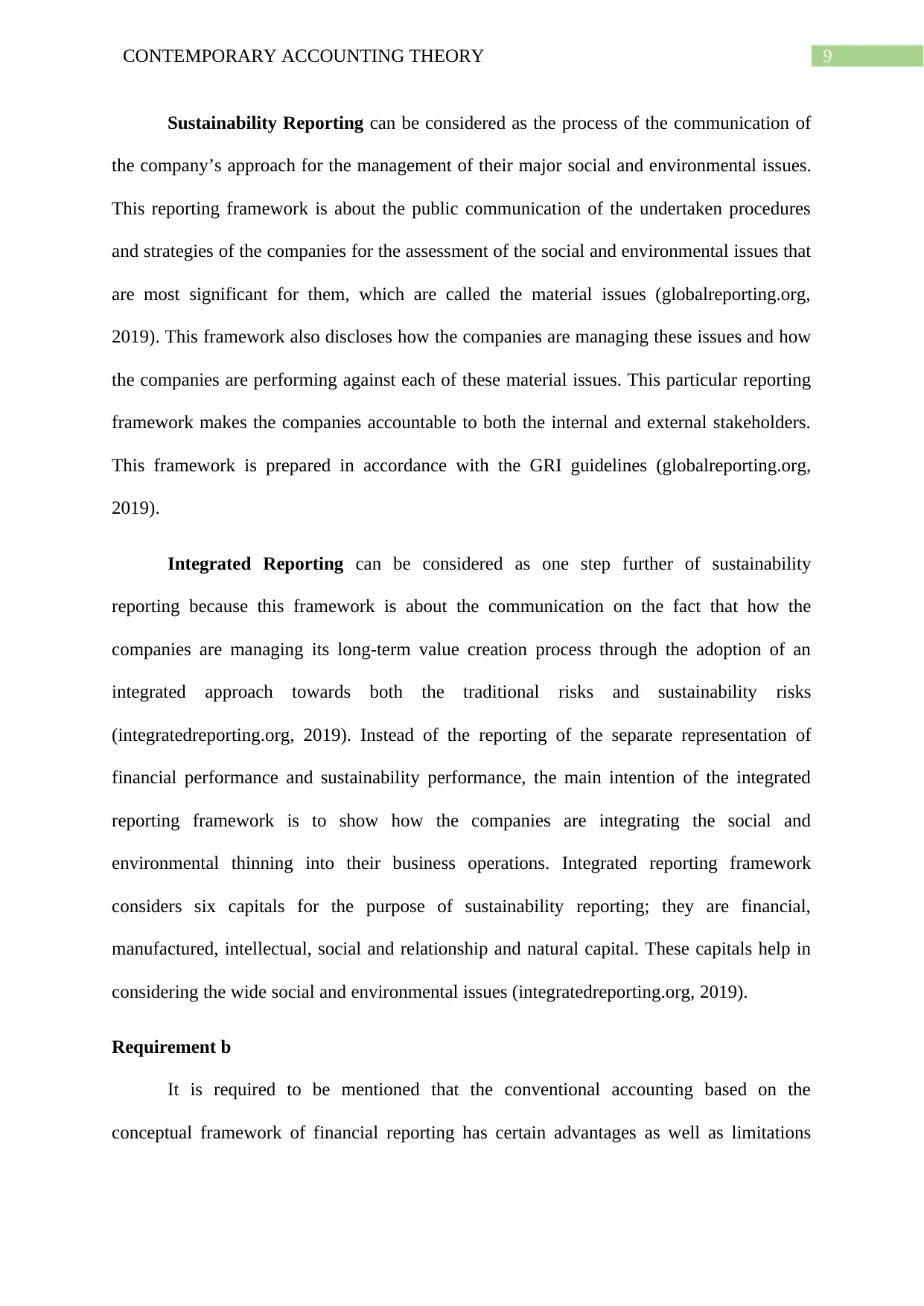
9CONTEMPORARY ACCOUNTING THEORY
Sustainability Reporting can be considered as the process of the communication of
the company’s approach for the management of their major social and environmental issues.
This reporting framework is about the public communication of the undertaken procedures
and strategies of the companies for the assessment of the social and environmental issues that
are most significant for them, which are called the material issues (globalreporting.org,
2019). This framework also discloses how the companies are managing these issues and how
the companies are performing against each of these material issues. This particular reporting
framework makes the companies accountable to both the internal and external stakeholders.
This framework is prepared in accordance with the GRI guidelines (globalreporting.org,
2019).
Integrated Reporting can be considered as one step further of sustainability
reporting because this framework is about the communication on the fact that how the
companies are managing its long-term value creation process through the adoption of an
integrated approach towards both the traditional risks and sustainability risks
(integratedreporting.org, 2019). Instead of the reporting of the separate representation of
financial performance and sustainability performance, the main intention of the integrated
reporting framework is to show how the companies are integrating the social and
environmental thinning into their business operations. Integrated reporting framework
considers six capitals for the purpose of sustainability reporting; they are financial,
manufactured, intellectual, social and relationship and natural capital. These capitals help in
considering the wide social and environmental issues (integratedreporting.org, 2019).
Requirement b
It is required to be mentioned that the conventional accounting based on the
conceptual framework of financial reporting has certain advantages as well as limitations
Sustainability Reporting can be considered as the process of the communication of
the company’s approach for the management of their major social and environmental issues.
This reporting framework is about the public communication of the undertaken procedures
and strategies of the companies for the assessment of the social and environmental issues that
are most significant for them, which are called the material issues (globalreporting.org,
2019). This framework also discloses how the companies are managing these issues and how
the companies are performing against each of these material issues. This particular reporting
framework makes the companies accountable to both the internal and external stakeholders.
This framework is prepared in accordance with the GRI guidelines (globalreporting.org,
2019).
Integrated Reporting can be considered as one step further of sustainability
reporting because this framework is about the communication on the fact that how the
companies are managing its long-term value creation process through the adoption of an
integrated approach towards both the traditional risks and sustainability risks
(integratedreporting.org, 2019). Instead of the reporting of the separate representation of
financial performance and sustainability performance, the main intention of the integrated
reporting framework is to show how the companies are integrating the social and
environmental thinning into their business operations. Integrated reporting framework
considers six capitals for the purpose of sustainability reporting; they are financial,
manufactured, intellectual, social and relationship and natural capital. These capitals help in
considering the wide social and environmental issues (integratedreporting.org, 2019).
Requirement b
It is required to be mentioned that the conventional accounting based on the
conceptual framework of financial reporting has certain advantages as well as limitations
Paraphrase This Document
Need a fresh take? Get an instant paraphrase of this document with our AI Paraphraser
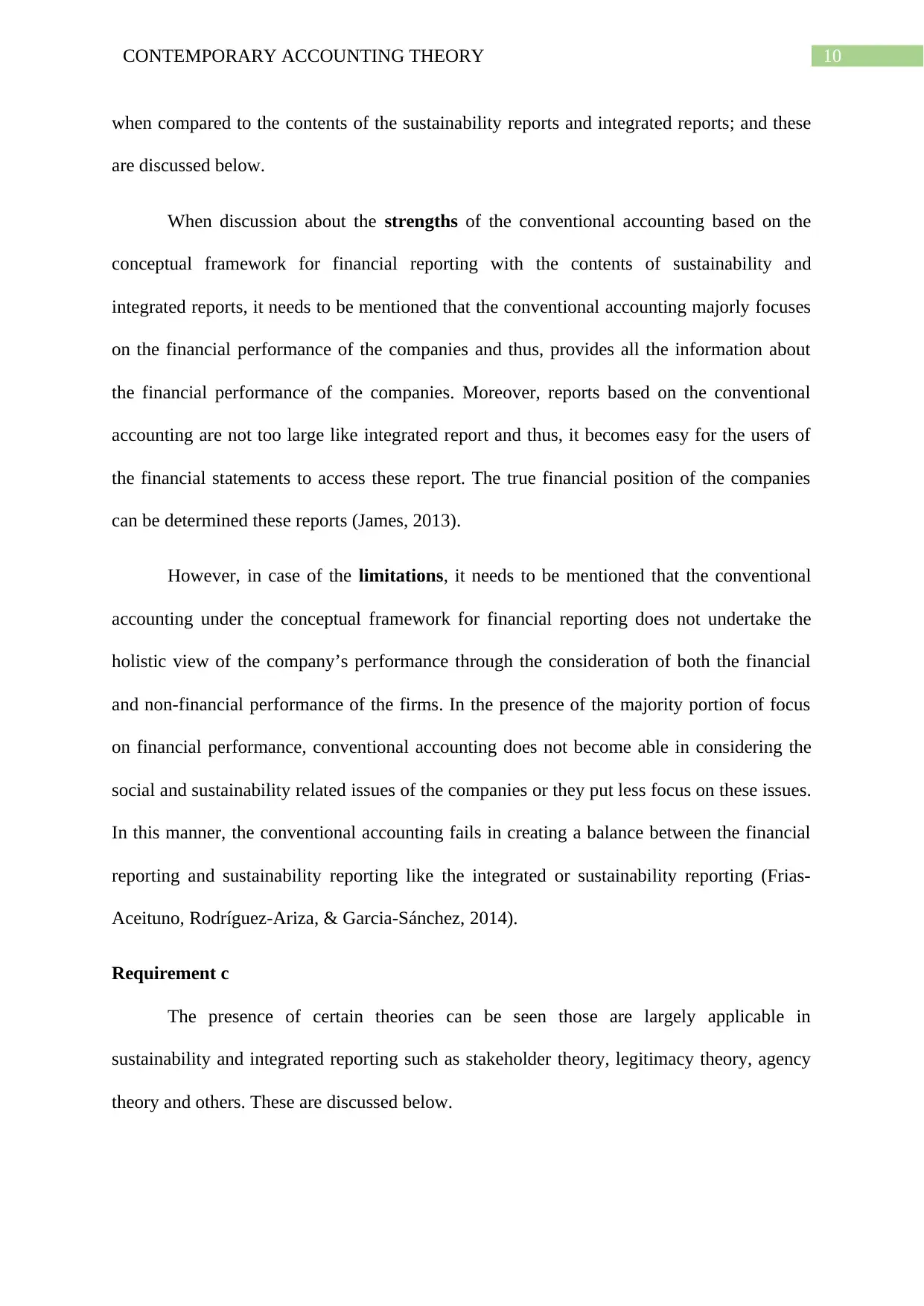
10CONTEMPORARY ACCOUNTING THEORY
when compared to the contents of the sustainability reports and integrated reports; and these
are discussed below.
When discussion about the strengths of the conventional accounting based on the
conceptual framework for financial reporting with the contents of sustainability and
integrated reports, it needs to be mentioned that the conventional accounting majorly focuses
on the financial performance of the companies and thus, provides all the information about
the financial performance of the companies. Moreover, reports based on the conventional
accounting are not too large like integrated report and thus, it becomes easy for the users of
the financial statements to access these report. The true financial position of the companies
can be determined these reports (James, 2013).
However, in case of the limitations, it needs to be mentioned that the conventional
accounting under the conceptual framework for financial reporting does not undertake the
holistic view of the company’s performance through the consideration of both the financial
and non-financial performance of the firms. In the presence of the majority portion of focus
on financial performance, conventional accounting does not become able in considering the
social and sustainability related issues of the companies or they put less focus on these issues.
In this manner, the conventional accounting fails in creating a balance between the financial
reporting and sustainability reporting like the integrated or sustainability reporting (Frias‐
Aceituno, Rodríguez‐Ariza, & Garcia‐Sánchez, 2014).
Requirement c
The presence of certain theories can be seen those are largely applicable in
sustainability and integrated reporting such as stakeholder theory, legitimacy theory, agency
theory and others. These are discussed below.
when compared to the contents of the sustainability reports and integrated reports; and these
are discussed below.
When discussion about the strengths of the conventional accounting based on the
conceptual framework for financial reporting with the contents of sustainability and
integrated reports, it needs to be mentioned that the conventional accounting majorly focuses
on the financial performance of the companies and thus, provides all the information about
the financial performance of the companies. Moreover, reports based on the conventional
accounting are not too large like integrated report and thus, it becomes easy for the users of
the financial statements to access these report. The true financial position of the companies
can be determined these reports (James, 2013).
However, in case of the limitations, it needs to be mentioned that the conventional
accounting under the conceptual framework for financial reporting does not undertake the
holistic view of the company’s performance through the consideration of both the financial
and non-financial performance of the firms. In the presence of the majority portion of focus
on financial performance, conventional accounting does not become able in considering the
social and sustainability related issues of the companies or they put less focus on these issues.
In this manner, the conventional accounting fails in creating a balance between the financial
reporting and sustainability reporting like the integrated or sustainability reporting (Frias‐
Aceituno, Rodríguez‐Ariza, & Garcia‐Sánchez, 2014).
Requirement c
The presence of certain theories can be seen those are largely applicable in
sustainability and integrated reporting such as stakeholder theory, legitimacy theory, agency
theory and others. These are discussed below.
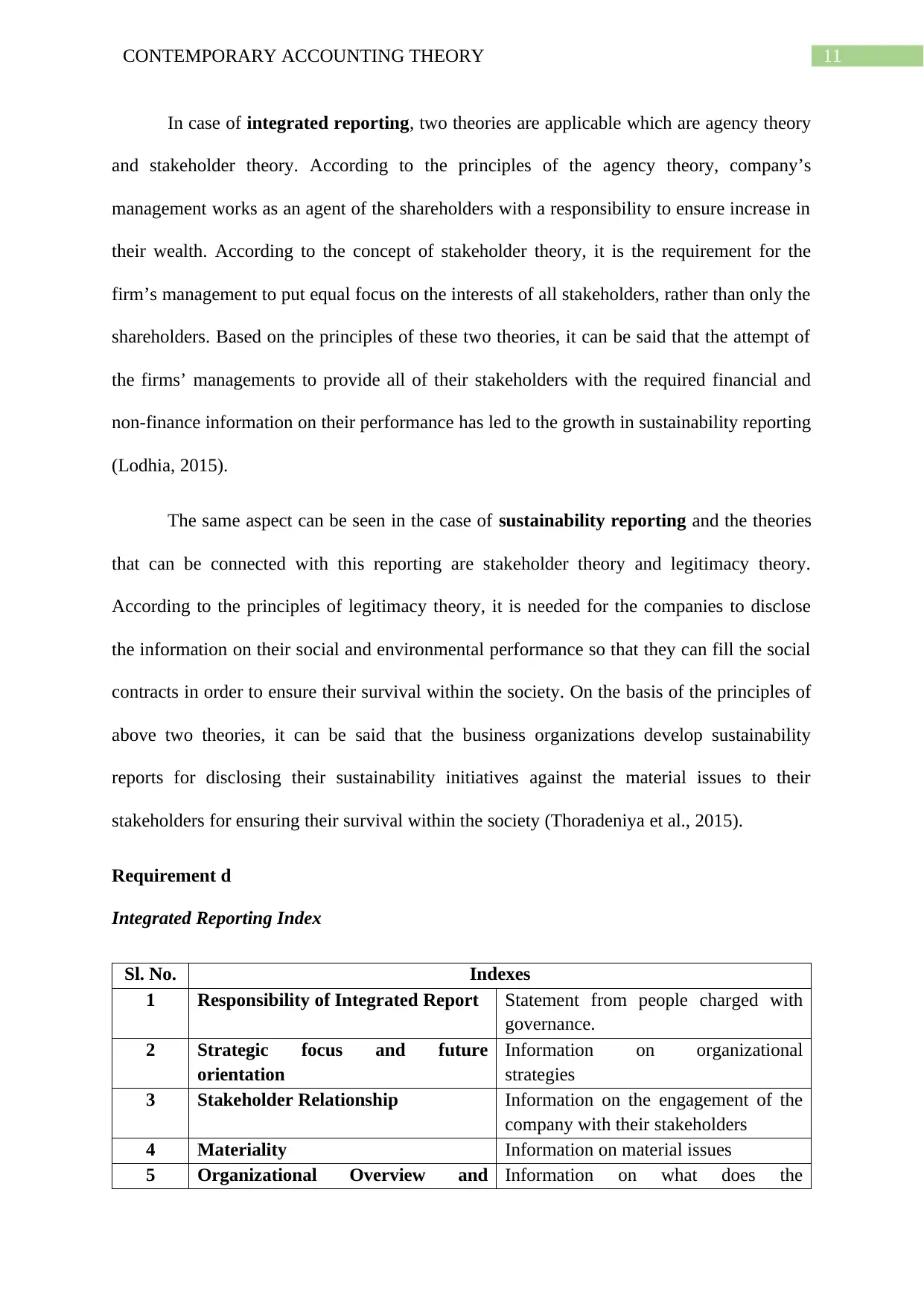
11CONTEMPORARY ACCOUNTING THEORY
In case of integrated reporting, two theories are applicable which are agency theory
and stakeholder theory. According to the principles of the agency theory, company’s
management works as an agent of the shareholders with a responsibility to ensure increase in
their wealth. According to the concept of stakeholder theory, it is the requirement for the
firm’s management to put equal focus on the interests of all stakeholders, rather than only the
shareholders. Based on the principles of these two theories, it can be said that the attempt of
the firms’ managements to provide all of their stakeholders with the required financial and
non-finance information on their performance has led to the growth in sustainability reporting
(Lodhia, 2015).
The same aspect can be seen in the case of sustainability reporting and the theories
that can be connected with this reporting are stakeholder theory and legitimacy theory.
According to the principles of legitimacy theory, it is needed for the companies to disclose
the information on their social and environmental performance so that they can fill the social
contracts in order to ensure their survival within the society. On the basis of the principles of
above two theories, it can be said that the business organizations develop sustainability
reports for disclosing their sustainability initiatives against the material issues to their
stakeholders for ensuring their survival within the society (Thoradeniya et al., 2015).
Requirement d
Integrated Reporting Index
Sl. No. Indexes
1 Responsibility of Integrated Report Statement from people charged with
governance.
2 Strategic focus and future
orientation
Information on organizational
strategies
3 Stakeholder Relationship Information on the engagement of the
company with their stakeholders
4 Materiality Information on material issues
5 Organizational Overview and Information on what does the
In case of integrated reporting, two theories are applicable which are agency theory
and stakeholder theory. According to the principles of the agency theory, company’s
management works as an agent of the shareholders with a responsibility to ensure increase in
their wealth. According to the concept of stakeholder theory, it is the requirement for the
firm’s management to put equal focus on the interests of all stakeholders, rather than only the
shareholders. Based on the principles of these two theories, it can be said that the attempt of
the firms’ managements to provide all of their stakeholders with the required financial and
non-finance information on their performance has led to the growth in sustainability reporting
(Lodhia, 2015).
The same aspect can be seen in the case of sustainability reporting and the theories
that can be connected with this reporting are stakeholder theory and legitimacy theory.
According to the principles of legitimacy theory, it is needed for the companies to disclose
the information on their social and environmental performance so that they can fill the social
contracts in order to ensure their survival within the society. On the basis of the principles of
above two theories, it can be said that the business organizations develop sustainability
reports for disclosing their sustainability initiatives against the material issues to their
stakeholders for ensuring their survival within the society (Thoradeniya et al., 2015).
Requirement d
Integrated Reporting Index
Sl. No. Indexes
1 Responsibility of Integrated Report Statement from people charged with
governance.
2 Strategic focus and future
orientation
Information on organizational
strategies
3 Stakeholder Relationship Information on the engagement of the
company with their stakeholders
4 Materiality Information on material issues
5 Organizational Overview and Information on what does the
⊘ This is a preview!⊘
Do you want full access?
Subscribe today to unlock all pages.

Trusted by 1+ million students worldwide
1 out of 19
Related Documents
Your All-in-One AI-Powered Toolkit for Academic Success.
+13062052269
info@desklib.com
Available 24*7 on WhatsApp / Email
![[object Object]](/_next/static/media/star-bottom.7253800d.svg)
Unlock your academic potential
Copyright © 2020–2025 A2Z Services. All Rights Reserved. Developed and managed by ZUCOL.





